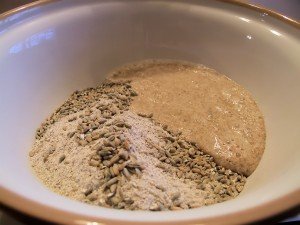Following on from the Ikea Brödmix Flerkorn post, I was inspired to create my own version of rugbrød (Danish rye bread). Since this is a naturally risen bread, I had to first create a sourdough starter since I had let my last one die a while ago. Bad owner.
As well as a sourdough starter I needed rye flour, rye berries (i.e. the whole grain) and kibbled rye (or sometimes called cut rye). The rye flour was easy enough, as most supermarkets carry it, but I went all over town looking for the rye berries and could only get them at Central Market. Kibbled rye was impossible to find, so I would had to produce it myself from the whole rye berries. I first tried to smash the rye grains with a motar and pestle without success. I tried cutting them in the food processor, but they quickly turned to flour. In the end I put them on a shallow metal tray and cut them using an Ulu. I think if I make rugbrød again I will invest in a small hand cranked grain mill.
Stage 1 – Ingredients
- 500g rye flour
- 100g whole rye berries
- 200g sourdough starter. see previous post on Sourdough pet
- 150g kibbled rye
- 750ml water
- 1 tsp salt
Mix all of the ingredients in a large mixing bowl, cover and leave to rise for approx. 12 hours. The mixture should be smelling sour and have risen by half. If you didn’t keep some of your sourdough starter, you can keep some of this mixture.
Stage 2 – Ingredients
- 150g kibbled rye
- 200g rye flour
- 2 tsp salt
- 150ml water
Mix the second batch of ingredients into the mixture. At this stage the mixture should be as hard to stir as concrete, but you can adjust with more water and flour if it is too loose or too tight. Transfer the mixture to 2, well greased bread tins approx 125mm x 230mm x 65mm (9″ x 5″ x 2.5″) leaving approx 3cm (1″) gap at the top of the tin for expansion. Place the tins in a switched off oven with a tray of boiling water in the bottom and leave for approx. 4 hours for the second rising. Remove the tray of water, set the oven to 160C (320F) and leave the bread to cook for approx 3 hours.
Enjoy slices with lashings of butter or use it to make Smørrebrød (Danish open sandwiches).I believe the Danes have an expression for the amount of butter you should spread on your bread called ‘tand smør’, which literately translates as ‘tooth butter’. This should be enough butter, so you can see teeth marks in it when you take a bite.





7 comments
Skip to comment form
omg!
very enterprising of you.
sounds like with a schmear..looks quite heavy
Thanks for the info!
Carolg
Author
Thanks. What does schmear mean? I looked at Wikipedia, but wasn’t quite sure of the connection.
Stuart, a schmear to the best of my knowledge is Yiddish slang that is used in bagel shops and delis in the northeast of the U.S.. when a customer orders a bagel as in “Everything bagel and a schmear of cream cheese.”. For me it means a heavy application of cream cheese or butter in a bagel.
Thanks! You know, you can order rye chops. I ordered some from a mill in NC; I found them via the web, of course. I keep them in the freezer.
Author
Can you remember the website name where you got the kibbled or cut rye berries?
I was in Denmark last year and it was nice to enjoy different types of bread, I was impressed with their baking recipes
Being Danish, I don’t have problems finding the ingredients for rugbrød, but I know how annoying it is when you want to bake something and you can’t find the required ingredients. I experience that regularly when I attempt various American recipes.
Just a comment on the “tooth butter”. It’s true that we use that term, but it’s definitely not something that “everybody” does. We’re generally quite health conscious! 🙂
For open faced sandwiches (which is the normal staple for most people for lunch) are usually buttered very thinly and then topped with various types of lunch meat, hardboiled eggs (sliced thinly), liver pate, some fish (fish patties, mackerel in tomato sauce, pickled herring, etc.), or just leftovers from last night’s dinner.